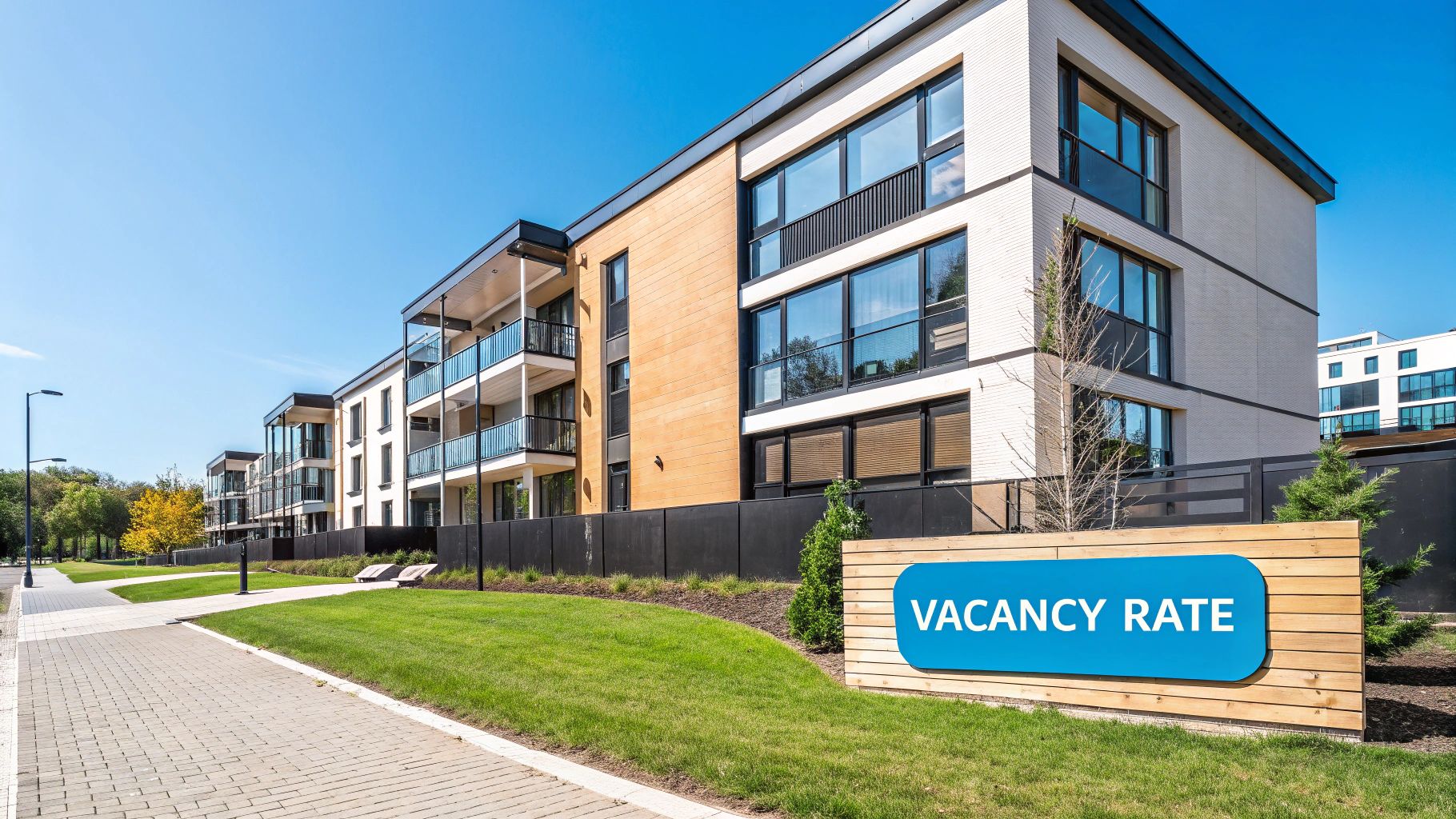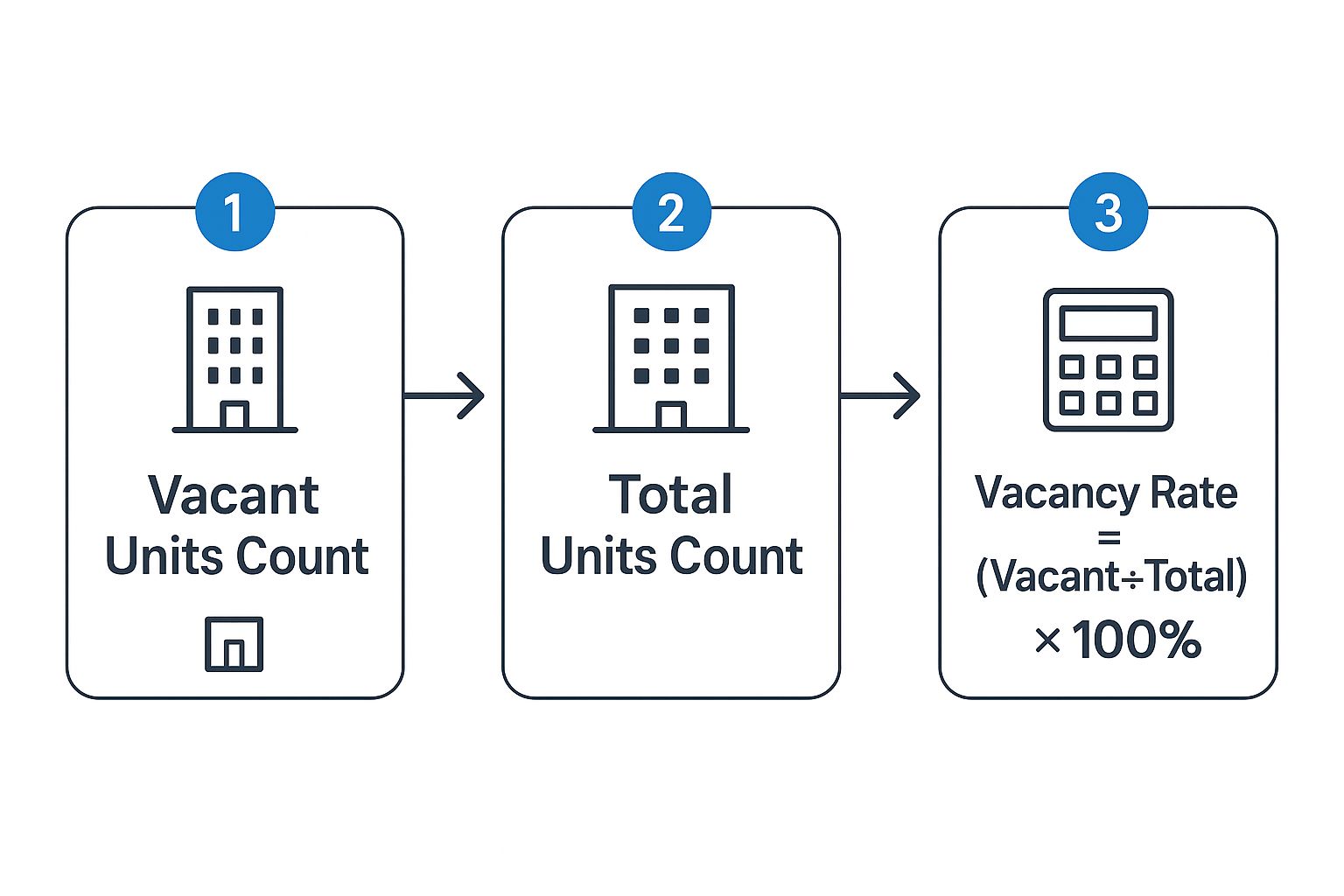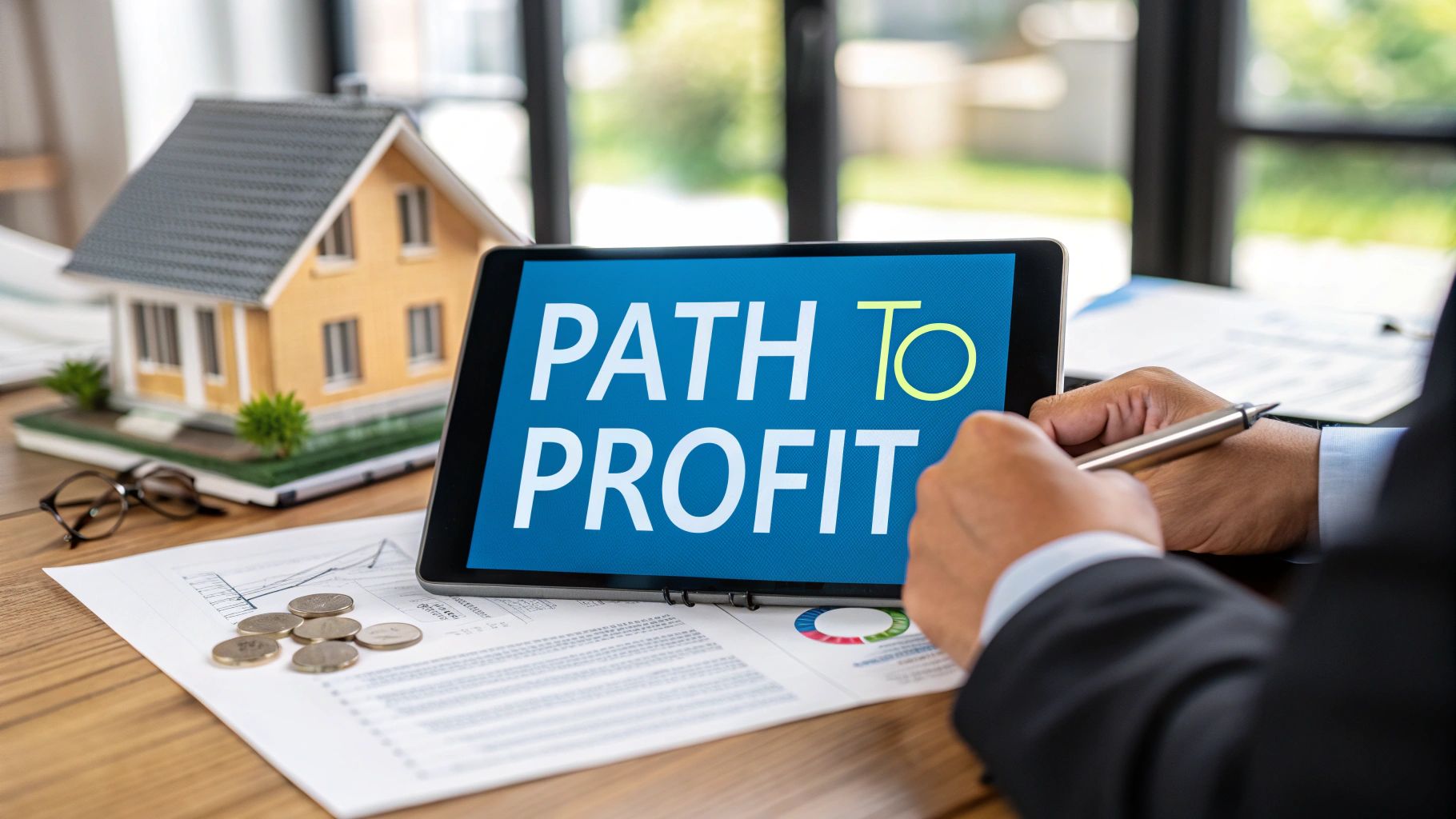To get a handle on your vacancy rate, the math is simple: just divide the number of empty units by the total number of units in your portfolio, then multiply by 100. This formula gives you a straightforward percentage—a critical snapshot of how much of your portfolio isn't bringing in revenue at any given moment.
Why Vacancy Rate Is a Critical Portfolio Health Metric
For property management companies juggling hundreds or even thousands of doors, vacancy rate isn't just another number. It's the pulse of your portfolio's financial health and a direct reflection of your operational efficiency. Every single day a unit sits empty, it directly impacts your revenue per door. Across a large, geographically dispersed portfolio, that lost revenue accumulates at an alarming rate.
Getting a firm grip on this metric is the absolute first step to fine-tuning every part of your leasing funnel and optimizing your speed-to-lease.

Connecting Vacancy to Scalable Operations
Think of a high vacancy rate as a symptom of deeper operational issues. It’s a bright red flag that can point to bottlenecks in your leasing pipeline, whether it’s slow lead response times, inefficient tour scheduling, or a unit turnover process that drags on for too long. For property management companies managing at scale, these seemingly small delays compound into major financial drains.
This single KPI has a domino effect on other metrics that successful enterprise-level PMs are obsessed with:
- Days on Market (DOM): A rising vacancy rate almost always goes hand-in-hand with an increasing DOM. The longer your units sit empty, the higher that vacancy percentage is going to climb, directly impacting potential income.
- Cost Per Door: Every vacant day adds to your overhead without bringing in a dime, which directly hurts your cost-per-door efficiency and overall portfolio profitability.
- Lead-to-Tour Conversion: If your leads aren’t turning into actual showings and applications, units stay empty. This is where showing availability becomes a massive lever, a topic we explore in our guide on how showing availability impacts vacancy rate. Optimizing this conversion is paramount for speed-to-lease.
The Financial Stakes of Vacancy
The true cost of an empty unit goes way beyond just the lost rent. You're also on the hook for marketing expenses, paying utilities on an empty property, and the administrative headache of keeping tabs on unoccupied homes across a distributed portfolio. A consistently high rate can make investors nervous and slam the brakes on portfolio growth.
For a 1,000-unit portfolio with an average rent of $2,000/month, a tiny 1% increase in the annual vacancy rate translates to a staggering $240,000 loss in potential gross income.
This is exactly why even small, incremental improvements in your leasing process can deliver a massive return on investment. Mastering your vacancy rate calculation is key to diagnosing problems, seeing how you stack up against the market, and making smart, data-driven decisions that actually boost your bottom line.
Understanding the Vacancy Rate Formula

On the surface, the vacancy rate formula seems simple enough. Most of us learned it on day one.
Vacancy Rate = (Number of Vacant Units / Total Number of Units) x 100
This quick calculation gives you a percentage—a snapshot of how much of your portfolio isn’t earning its keep. But when you’re managing hundreds or even thousands of doors across different markets, the real challenge is standardizing what the numbers actually mean.
If your team isn't on the same page about what counts as a "vacant" unit, your data is compromised. Inconsistent definitions lead to flawed analysis, which leads to poor strategic decisions that can cost millions across a large portfolio. It’s that simple.
Defining a Vacant Unit for Enterprise Operations
The key to achieving accuracy at scale is creating a universal definition that your entire operations team adheres to, regardless of market. Is a "vacant" unit just one that's sitting empty between leases? What about a property undergoing a major rehab that is completely un-leasable?
To make your vacancy rate a truly meaningful metric, you need to standardize how you classify every unit in your PMS.
Here’s a practical framework for enterprise-level property management:
- Rent-Ready Units: These are clearly vacant, available for lease, and must be counted. This is the baseline.
- Units in Turnover: A unit in the midst of a standard make-ready process is absolutely vacant. In fact, tracking these units is how you measure turnover efficiency—a critical factor in shrinking your Days on Market (DOM) and accelerating speed-to-lease.
- Down Units: Properties that are un-leasable because of major repairs or renovations must be counted. Excluding them artificially lowers your vacancy rate and masks deeper operational problems or capital expenditure needs that impact portfolio performance.
This metric is a core KPI in numerous industries. The data center market, for example, uses the same formula to track unoccupied server space. A recent report from CBRE showed that intense demand drove the average vacancy rate across major North American data centers to a record low of 3.3% in H1 2023. It’s a powerful indicator of market health, no matter the asset class.
By creating—and enforcing—a consistent definition of vacancy within your core systems, you ensure every single person on your team is feeding into one reliable source of truth. That’s how you get data you can actually trust to make strategic decisions for your portfolio.
A Practical Walkthrough: Calculating Your Vacancy Rate
Theory is great, but let's apply this to a real-world scenario. Imagine you're an operations director managing a portfolio of 1,500 single-family rentals scattered across multiple markets. Figuring out your vacancy rate is the first, most critical step to plugging revenue leaks and spotting operational drag.
The basic formula seems simple enough, but when you're dealing with a large portfolio, your calculation is only as good as your data. This is why pulling clean, consistent numbers straight from your Property Management Software (PMS) is absolutely non-negotiable. Trying to track this manually in spreadsheets is a recipe for disaster at scale—it just creates messy data that hides the real story.
A Better Metric for Large Portfolios: From Counting Units to Counting Days
Just counting empty units only gives you a quick snapshot. For a much clearer view of the financial impact, you need to calculate your vacancy rate based on vacant days. This method accounts for units that were only empty for a portion of the month, giving you a truer picture of lost revenue and operational efficiency. It's the metric that matters for ROI analysis.
The formula changes slightly but is far more powerful:
Vacancy Rate by Days = (Total Vacant Days in Period / Total Possible Rental Days in Period) x 100
Let's break this down using a single month, say June (30 days), for that 1,500-unit portfolio:
- Total Possible Rental Days: 1,500 units x 30 days = 45,000 total rentable days. This is your denominator, your total revenue potential.
- Total Vacant Days: You run a report in your PMS and find that the sum of all days every single unit sat empty in June was 2,700 days.
Now, just plug those numbers into the formula:
(2,700 Vacant Days / 45,000 Possible Days) x 100 = 6.0%
That 6.0% is a seriously powerful KPI. It’s not some abstract number; it represents 2,700 days of missed revenue opportunities. It's a hard figure you can act on, directly linking operational performance to financial outcomes.

Once you master this calculation using vacant days, you can start accurately benchmarking performance across your different markets or property types. It gives you a direct line of sight into how your Days on Market (DOM) is affecting your bottom line, arming you with the insights you need to truly optimize your leasing operations at scale.
Using Vacancy Data to Drive Smarter Decisions

Calculating your vacancy rate is just the first step. The real value comes when you use that number to ask tougher, more strategic questions about your portfolio. A single percentage point can signal deep-seated operational issues that, if ignored, will consistently eat into your revenue and erode cost-per-door efficiency.
First thing’s first: you need context. How does your current rate stack up against last quarter? What about this time last year? And even more importantly, how does it compare to the local market average? This quick benchmark tells you whether your vacancy problem is specific to your operational performance or part of a bigger market trend.
Connecting Vacancy to Critical KPIs
A rising vacancy rate rarely happens in a vacuum. It's a lagging indicator, often pointing to bottlenecks somewhere in your leasing pipeline. This is where you must connect the dots between your vacancy rate and the other core metrics you’re already tracking in your enterprise systems.
A high rate could be a symptom of several operational drags:
- Elevated Days on Market (DOM): This is the most direct link. The longer a unit sits empty, the higher your vacancy rate climbs. If you see a sudden spike in vacancy, your DOM trends are the first place to look.
- Low Lead-to-Tour Conversion: Are leads pouring in but never making it to a showing? This bottleneck leaves units sitting empty and usually points to slow lead response, scheduling friction, or a lack of showing availability for qualified prospects.
- Inefficient Turnover Process: If your units are stuck in make-ready limbo for weeks, they're contributing directly to your vacancy days. This metric can expose costly delays between one tenant moving out and the next one moving in, which is deadly for remote management operations.
By diagnosing the root cause—whether it’s pricing, marketing, or operational friction—you can implement targeted, scalable solutions. For example, if your pricing is competitive, maybe the leasing process itself is the problem. Sometimes, all it takes are a few smart improvements, like offering attractive apartment leasing incentives can help fill vacancies faster and get your numbers back where they should be.
Go Beyond Physical Vacancy with Economic Vacancy
If you're managing a larger portfolio, you already know that physical vacancy only tells half the story. A unit might have a signed lease, but if you aren't collecting the full market rent, it's not performing at its peak potential.
This is where the concept of economic vacancy comes in. It gives you a much sharper, more accurate picture of your portfolio's true financial health and revenue leakage.
Economic vacancy measures the gap between your portfolio’s Gross Potential Income (GPI) and what you actually collect. Think of it as the real financial leakage that a simple physical vacancy rate can easily hide.
What Economic Vacancy Accounts For
This metric is a powerful diagnostic tool because it digs deeper, including all the different ways you might be losing revenue—not just from empty units.
- Rent Concessions: That "one month free" offer on a 12-month lease? It instantly creates an 8.3% economic vacancy for that unit's annual term, even though it’s physically occupied from day one.
- Delinquencies and Bad Debt: Uncollected rent from tenants who are still in their units is a direct hit to your bottom line. This is a core component of economic vacancy that impacts your net operating income.
- Below-Market Leases: Let's say you have a unit leased for $1,800, but the current market rate is $2,000. That $200 monthly difference is a form of economic vacancy you need to be tracking across the portfolio.
- Physical Vacancy: Of course, the revenue lost from physically empty units is still a major factor. To get a better handle on the direct impact here, it's worth exploring the common risks of unoccupied vacant properties.
This concept of tracking under-utilization isn't unique to residential real estate. In the corporate world, a similar calculation helps companies quantify the cost of unused office space. For instance, a 2023 JLL report found that on peak days, office utilization was still only around 60%, implying a massive economic vacancy of 40% as companies pay for workspaces that sit empty.
When you start tracking economic vacancy, you shift your focus from just filling units to maximizing the collected revenue from every single door. It’s the kind of financial clarity that enables smarter decisions on everything from rent concessions and tenant screening to renewal strategies across your entire portfolio.
Diving Deeper: Your Vacancy Rate Questions Answered
Even the most experienced portfolio managers run into questions when they try to standardize vacancy rate calculations, especially across different markets. Getting these details right isn't just about clean data—it's about making confident, revenue-driven decisions.
Let's dig into some of the most common questions we hear from property managers running large, distributed portfolios.
How Often Should I Be Calculating My Portfolio's Vacancy Rate?
For real-time, actionable insights, monthly is the gold standard. Period. Calculating it this frequently allows your operations team to catch trends as they emerge, react to market shifts on the fly, and see if your leasing strategies are actually working before a small leak turns into a significant revenue drain.
Quarterly and annual calculations still have their place, of course. Just think of them as serving a different purpose—they’re perfect for high-level financial reports, investor updates, and long-term strategic planning.
What’s a Good Vacancy Rate for a Large Portfolio?
The typical industry benchmark you'll hear thrown around is somewhere between 5% and 8%. But honestly, for a scaled portfolio, your main goal should always be simpler: consistently beat your local market's average. That's the real win.
It's also critical to look at the flip side. A vacancy rate that's always dipping below 5% might not be the victory it seems. More often than not, it's a flashing neon sign that your rents are too low and you're leaving money on the table.
Should I Count Units in Turnover in My Calculation?
Yes, you absolutely have to. From a revenue perspective, a unit being turned over is a non-generating asset, plain and simple. If you exclude it from your vacancy calculation, you're just painting an overly rosy picture of your portfolio's health that isn't based in financial reality.
In fact, tracking turnover units as part of your vacancy is one of the best ways to keep a pulse on your make-ready process. If you see vacant units getting stuck in turnover, you've found a bottleneck that's stretching out your Days on Market (DOM) and costing you real money every single day.
How Does Vacancy Rate Connect to Days on Market?
Think of Vacancy Rate and Days on Market (DOM) as two sides of the same coin. They're completely intertwined and mission-critical for large portfolios.
- Vacancy rate is your snapshot in time—it tells you how many units are empty right now, impacting current revenue.
- Days on Market (DOM) is all about duration—it tells you how long each of those empty units stays that way, predicting future vacancy.
A high average DOM will always inflate your overall vacancy rate. It’s a direct cause and effect. That means the most powerful lever you can pull to lower your vacancy rate—and boost your revenue—is to shrink your DOM by making your leasing operations faster and more efficient from lead to lease.
Ready to shrink your Days on Market and drive down your vacancy rate? Showdigs automates the entire leasing process, from lead response to showing, helping large portfolios get units leased faster. Discover how our AI-backed platform can optimize your operations.







